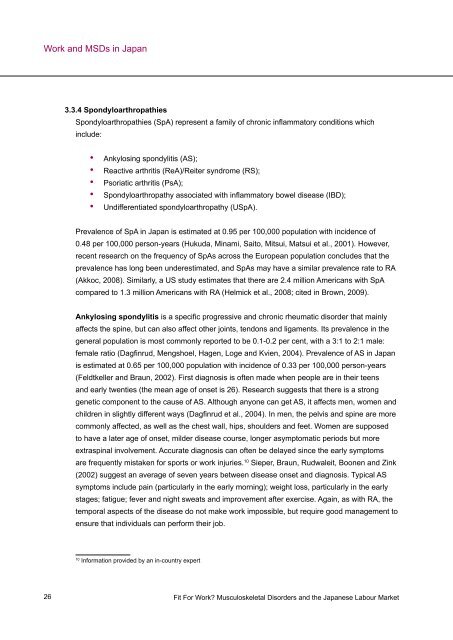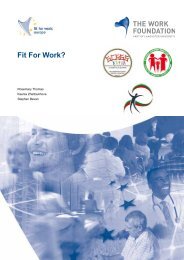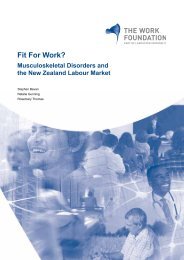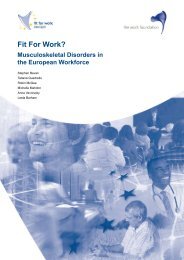English version - Fit for Work Europe
English version - Fit for Work Europe
English version - Fit for Work Europe
Create successful ePaper yourself
Turn your PDF publications into a flip-book with our unique Google optimized e-Paper software.
<strong>Work</strong> and MSDs in Japan<br />
26<br />
3.3.4 Spondyloarthropathies<br />
Spondyloarthropathies (SpA) represent a family of chronic inflammatory conditions which<br />
include:<br />
• Ankylosing spondylitis (AS);<br />
• Reactive arthritis (ReA)/Reiter syndrome (RS);<br />
• Psoriatic arthritis (PsA);<br />
• Spondyloarthropathy associated with inflammatory bowel disease (IBD);<br />
• Undifferentiated spondyloarthropathy (USpA).<br />
Prevalence of SpA in Japan is estimated at 0.95 per 100,000 population with incidence of<br />
0.48 per 100,000 person-years (Hukuda, Minami, Saito, Mitsui, Matsui et al., 2001). However,<br />
recent research on the frequency of SpAs across the <strong>Europe</strong>an population concludes that the<br />
prevalence has long been underestimated, and SpAs may have a similar prevalence rate to RA<br />
(Akkoc, 2008). Similarly, a US study estimates that there are 2.4 million Americans with SpA<br />
compared to 1.3 million Americans with RA (Helmick et al., 2008; cited in Brown, 2009).<br />
Ankylosing spondylitis is a specific progressive and chronic rheumatic disorder that mainly<br />
affects the spine, but can also affect other joints, tendons and ligaments. Its prevalence in the<br />
general population is most commonly reported to be 0.1-0.2 per cent, with a 3:1 to 2:1 male:<br />
female ratio (Dagfinrud, Mengshoel, Hagen, Loge and Kvien, 2004). Prevalence of AS in Japan<br />
is estimated at 0.65 per 100,000 population with incidence of 0.33 per 100,000 person-years<br />
(Feldtkeller and Braun, 2002). First diagnosis is often made when people are in their teens<br />
and early twenties (the mean age of onset is 26). Research suggests that there is a strong<br />
genetic component to the cause of AS. Although anyone can get AS, it affects men, women and<br />
children in slightly different ways (Dagfinrud et al., 2004). In men, the pelvis and spine are more<br />
commonly affected, as well as the chest wall, hips, shoulders and feet. Women are supposed<br />
to have a later age of onset, milder disease course, longer asymptomatic periods but more<br />
extraspinal involvement. Accurate diagnosis can often be delayed since the early symptoms<br />
are frequently mistaken <strong>for</strong> sports or work injuries. 10 Sieper, Braun, Rudwaleit, Boonen and Zink<br />
(2002) suggest an average of seven years between disease onset and diagnosis. Typical AS<br />
symptoms include pain (particularly in the early morning); weight loss, particularly in the early<br />
stages; fatigue; fever and night sweats and improvement after exercise. Again, as with RA, the<br />
temporal aspects of the disease do not make work impossible, but require good management to<br />
ensure that individuals can per<strong>for</strong>m their job.<br />
10 In<strong>for</strong>mation provided by an in-country expert<br />
<strong>Fit</strong> For <strong>Work</strong>? Musculoskeletal Disorders and the Japanese Labour Market







